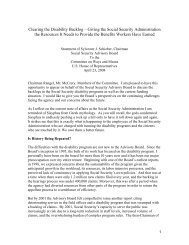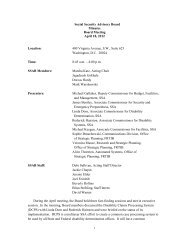Aspects of Disability Decision Making: Data and Materials
Aspects of Disability Decision Making: Data and Materials
Aspects of Disability Decision Making: Data and Materials
Create successful ePaper yourself
Turn your PDF publications into a flip-book with our unique Google optimized e-Paper software.
1989 The Omnibus Budget Reconciliation Act <strong>of</strong> 1989 (P.L. 101‐239) required the Secretary <strong>of</strong> HHS toestablish <strong>and</strong> conduct an ongoing program <strong>of</strong> outreach to children who are potentially eligible forSSI benefits because <strong>of</strong> disability or blindness.1990 SSA published new regulations (in 20 CFR 404.985 <strong>and</strong> 416.1485) reinforcing its existing acquiescencepolicy <strong>and</strong> exp<strong>and</strong>ing it to include all levels <strong>of</strong> the adjudication process (55 FR 1012 (January11, 1990)).On February 20, 1990, the Supreme Court in Sullivan v. Zebley, 493 U.S. 521 (1990), ruled that thegovernment’s policy on disability determinations for SSI children held children erroneously to astricter definition <strong>of</strong> disability than the st<strong>and</strong>ard for adults.The Omnibus Budget Reconciliation Act <strong>of</strong> 1990 (P.L. 101‐508) made several important changes tothe law. It:■■reduced the percentage <strong>of</strong> favorable DDS decisions that must be reviewed by SSA from65 percent to 50 percent;■■required review <strong>of</strong> a sufficient number <strong>of</strong> unfavorable determinations to ensure a high degree<strong>of</strong> accuracy;■■made permanent the statutory provision for continued payment during appeal <strong>of</strong> adverseCDRs; <strong>and</strong>■■changed the definition <strong>of</strong> disability for widows <strong>and</strong> widowers to the same definition used forworkers.The law also required the Secretary <strong>of</strong> HHS to make reasonable efforts to ensure that, when evaluatingdisability for a child, a qualified pediatrician or other individual who specializes in a field <strong>of</strong>medicine appropriate to the disability <strong>of</strong> the child evaluate the case.SSA published rules exp<strong>and</strong>ing the Listing <strong>of</strong> Impairments with respect to the evaluation <strong>of</strong> mentaldisorders in children (55 FR 51208 (December 12, 1990)).1991 SSA issued new regulations in response to the Zebley Supreme Court decision implementing anew disability evaluation process for SSI children (56 FR 5534 (February 11, 1991)). The newrules established a procedure for evaluating whether a child’s impairments were “functionallyequivalent” to the Listing <strong>of</strong> Impairments <strong>and</strong>, if not, for making an “Individualized FunctionalAssessment” to determine disability based on less severe functional limitations.SSA issued new regulations (56 FR 36932 (August 1, 1991)) implementing provisions <strong>of</strong> The SocialSecurity <strong>Disability</strong> Benefits Reform Act <strong>of</strong> 1984 requiring that SSA establish st<strong>and</strong>ards for consultativeexaminations, consider all <strong>of</strong> the evidence available in a claimant’s case record, <strong>and</strong> developa complete medical history covering at least the preceding 12 months. The new regulations alsoaddressed the evaluation <strong>of</strong> pain <strong>and</strong> other symptoms, <strong>and</strong> provided rules on the evaluation <strong>of</strong>medical opinion evidence, including the opinions <strong>of</strong> claimants’ treating physicians.1992 Beginning in 1992, State-wide class action suits were filed in Iowa, Nebraska, Oregon, <strong>and</strong> Utahagainst State DDSs <strong>and</strong> the Federal government alleging that adjudicators used improper policies<strong>and</strong> procedures when making disability determinations. The issues included development <strong>and</strong>consideration <strong>of</strong> treating source medical evidence <strong>and</strong> opinion; evaluation <strong>of</strong> the credibility <strong>of</strong> anindividual’s statement <strong>of</strong> symptoms, including pain; appropriate use <strong>of</strong> vocational resources <strong>and</strong>evaluation <strong>of</strong> vocational evidence; <strong>and</strong> Federal oversight <strong>of</strong> the DDSs. The cases were settled withagreements that included re-evaluation <strong>of</strong> certain previously denied claims <strong>and</strong> ongoing communicationswith plaintiffs’ representatives to discuss concerns related to the disability determinationprocess.94 <strong>Aspects</strong> <strong>of</strong> <strong>Disability</strong> <strong>Decision</strong> <strong>Making</strong>: <strong>Data</strong> <strong>and</strong> <strong>Materials</strong>









